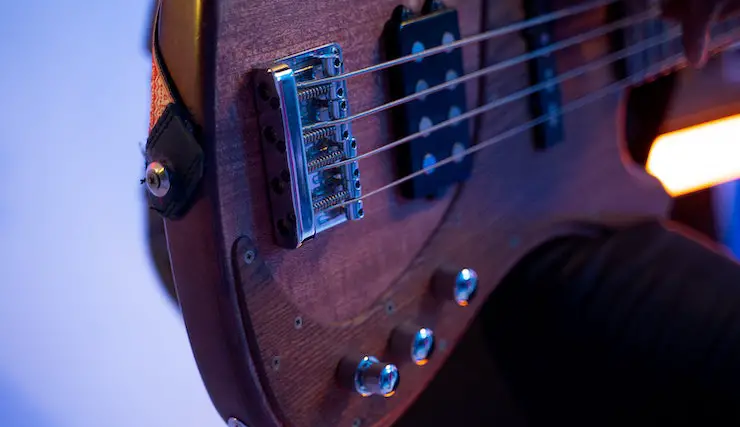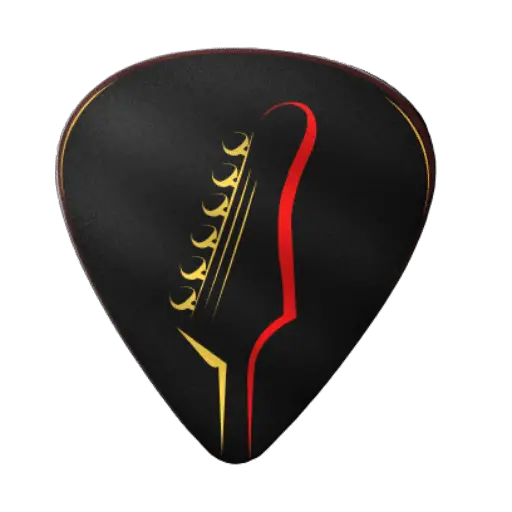Drop F Tuning Six String?
Drop F tuning for a 6-string guitar lowers the pitch of the six strings in six or three complete steps. The string’s pitch is tuned F, A#, D#, G#, C, and F in this tuning. That means the string with the lowest pitch, usually the 6th one, can be tuned with F instead of the normal E. The reason for using drop F tuning is that it allows you to produce the sound of a high and low pitch for the guitar, specifically for genres such as metal and heavy rock.
Suppose you tune your guitar to a lower F to create an even more powerful and angrier sound. The lower pitch of the strings allows for powerful and heavy riffs and a stout chord progression. This tuning is frequently preferred by guitarists who want an edgier and more terrifying tone in their music.
It is important to remember that dropping F tuning requires larger gauge strings to maintain an appropriate tension and avoid excessive string floppiness. Strings with a higher gauge are essential to ensure a stable tension without the string getting too loose. This helps to improve the tonality and reduce fret buzz.
It’s also worth noting that dropping F tuning could put additional stress on the neck and bridge because of the higher tension of the more hefty strings. It’s recommended to talk with an expert guitar technician or luthier to ensure your guitar is equipped to handle the strain and avoid harm.
Overall, dropping F-tuning for a six-string guitar can produce a booming, low-end tone that can boost the volume and intensity of your play. It’s crucial to consider the gauge of your strings and the strain that could be placed on your instrument; however, with the right setup, dropping F tuning opens an entirely new world of possibilities for making powerful music.
Which Tune Do I Do? | Six-String to Drop F?

To tune a guitar with six strings to drop F, you must reduce your string’s pitch by six half steps or three complete steps. This is a thorough description of how to tune each string to achieve a dropping F tune:
The 6th String is lower (Low E string) to F
Start by loosening up the tension on your 6th string. It is usually tuned to note E. Adjust the peg on six strings counterclockwise to reduce the pitch. Adjust the tuning peg until your String is tuned to F. It is possible to use the electronic tuner tuning application or another instrument of reference to assist you in achieving the right pitch.
Tune the 5th String (A string) to A
Then, you can move to the 5th string and tune it until it is tuned to A#. Begin by plucking the opestring to its pitch with the A# note in your tuning device or another reference instrument. Set the tuning peg on a fifth string to ensure it fits the pitch you want to hear from A#.
The 4th String is lowered (D string) to D
Then, concentrate on the 4th string and tune it until D#. Pull the open 4th string and check its pitch against that note on the tuning device or other reference instrument. Utilize the tuning peg on the fourth string to alter the pitch until it matches that of the D# note.
Tune the 3rd string (the G string) to G
Move to the third string, and then tune it until G#. Pick the open third string and check its pitch against the G# note on your tuner or another reference instrument. The tuning peg can be adjusted on the third string to ensure that the note reaches the pitch you want to hear, G#.
The 2nd String is lowered (B string) to C
Focus on the 2nd String, and adjust it to C. Pick the second string and compare its pitch with the C note on your tuner or instrument of reference. Use the tuning peg of the second string to alter the pitch until it matches the C note’s.
The 1st String should be tuned (High E string) to F
Finally, tune the first String until it is tuned to F. Pick the open string and check its pitch against that of F on your tuner or instrument of reference. The tuning peg can be adjusted on the first String till the instrument reaches that desired note of F.
Ensure you tune each string properly and make any adjustments necessary to get a precise tuning. Utilizing an electric tuner or a trusted tuning application is recommended to guarantee exact results.
Once you’ve tuned the six strings according to their respective pitches (F A#, D# G#, and F), Your guitar will be tuned to tuning with a drop F. Note that this tuning will require larger gauge strings to maintain proper tension and avoid excessive flopping of the strings.
What Is The Drop F Scale?

Drop-F tuning doesn’t necessarily mean that it is a particular scale. The scale you choose for drop F tuning will depend on your preference for music and the context in which you’re playing. But for now, I’m able to provide some insight and suggestions on scales that are suitable for drop tuning:
F Natural Minor (Aeolian) Scale
A popular choice can be the F natural minor scale, referred to as the Aeolian mode. The scale comprises five notes: F, G, Ab, Bb, C, Db, and Eb. It has a melancholy, dark sound that is frequently used across various genres, including rock and metal.
F Harmonic Minor Scale
Another alternative is the F harmonic minor scale. It has similar notes to those of the F natural minor scale but with a higher seventh degree. The scale consists of the notes F G, C Bb, and C Db. The elevated 7th degree (E) increases tension and gives an exotic taste to the scale. It’s often found in classical and metal music.
F Phrygian Dominant Scale
The F Phrygian dominant scale, sometimes referred to as the Spanish Phrygian scale, is a different and interesting option. It has a distinct Middle Eastern or flamenco flavor. The scale comprises five notes: F, Gb, Ab, B, C, Db, ad. Its raised third (B) and the perfect low second (Gb) are the main factors in the distinctive sound. It is frequently employed in different kinds that incorporate heavy and orchestral music.
F Blues Scale
If you want to hear a bluesy sound, you can use it to play the F blues scale. It is an amalgamation of the pentatonic scale. It also has additional “blue” notes. With drop F tuning, the F blues scale is comprised of the notes F, Ab, Bb, and C. It also includes B, C, and Eb. It has a rich and evocative sound commonly used in blues, rock, or jazz.
F Diminished Scale
A scale called the F diminished scale can be a fascinating option that creates an atmosphere of dissonance and tension. The scale alternates between complete steps and half-steps. It is frequently connected with suspenseful and intense musical passages. With drop F tuning, this F diminished scale contains the notes F G, F Bb Cb (or B), Db D#, and E.
Be aware that these are just the most common samples of scales that may be utilized in dropping F tuning. Playing with various scales and modes can let you discover different musical sounds and possibilities. Investigating different melodic patterns, scales, and chord progressions is important to maximize the benefits of dropping the F tuning in your playing.
How Do I Tune The Instrument String F Standard?

“F standard” is not an acceptable tuning for guitars. However, if you’re trying to tune your guitar’s 6-strings according to the F standard, in which every string is tuned to F, here’s an in-depth description of how to accomplish that:
Choose the appropriate string gauge
Tuning all strings to F requires substantial tension, so selecting stronger gauge strings is important. The more string-thinner strings help to maintain tension and stop excessive strings from flopping. You may want to consider using a set of strings designed specifically to be tuned lower or seek out a guitar professional to get recommendations.
The 6th String is lower (Low E string) to F
Begin by loosening up the tension of the 6th string, which is typically tuned up to the E. Adjust the peg on your 6th String clockwise and reduce to a pitch that is F. Make use of an electronic tuner or reference pitch to assure accuracy.
Make sure the other strings are tuned to match the 6th String
To tune the rest of the strings to F, you can apply the relative tuning method. Here’s how:
Fifth String (A string)
Place the 6th string on the 5th fret, and then pluck it. Then, you can pluck the open fifth string (the A string). The tuning peg can be adjusted on the string so the pitch sounds like the string on the 5th fret.
Fourth String (D string)
The 5th is pressed at the 5th fret and then plucked. You can pluck the open fourth string (string). Set the tuning peg of the 4th so the pitch sounds like the 5th string frets.
Third-string (G string)
The 4th string The string is pressed at the 5th fret and pounded. In parallel, pluck the string S (the ring) (the G string). The tuning peg can be adjusted on a third string so that its pitch sounds like the fourth string on the fifth fret.
2nd String (B string)
The 3rd string is pressed at the 4th fret and plucked. In parallel, pluck the second string (the B string). The tuning peg can be adjusted on the 2nd string until its pitch is in tune with the sound of the 3rd string located at 4.
1st String (High E String)
The 2nd String is pressed at the 5th fret, then play it. Then, pluck the first one that is open high the highering). Set the peg of tuning of the first String at the pitch is in tune with the sound of the second string on the fifth fret.
Be sure to tune each string in a controlled manner and make the small adjustments required to get a precise tuning. It is suggested that you use your own electronic tuner and a reliable app for tuning to get accurate results.
Be aware that tuning your instrument to the F standard could put extra tension on the bridge and neck due to the higher tension of the larger strings. Speaking with an expert guitar technician or luthier is recommended to ensure your guitar is tuned to take the pressure and avoid any injury.
Drop The F String Gauge?

In tuning down to drop F, it is crucial to select a suitable string gauge that can handle the tension increase and maintain the proper level of playing ability. Here’s a comprehensive explanation of the gauge of string for tuning drop F:
Consider heavier string gauges
It is recommended to use strings with a greater gauge than the regular tuning to attain drop F tuning. The heavier gauge strings offer more tension and prevent excessive string floppiness that can cause a loss of sound and playability. Thicker strings also allow an even tone and lessen the rattling or buzzing.
Choose a balanced string set
It’s crucial to choose an instrument specifically made for lower tunings like drops F. These strings are usually described with the words “heavy” or “baritone” gauge and are designed to handle the higher tension required for lower tunings.
Ask a guitar tech or the luthier
If you’re not sure which particular string gauge you should select for drop F, it may be beneficial to seek the services of a guitar technician or luthier. They’ve worked with various gauges of strings and can offer suggestions based on the guitar’s specifications and your style of playing.
Take into consideration your personal preferences and playing ability
Be aware that your preference and playing ability are equally important when choosing the right gauge for your string. The heavier strings will require more strength from the fingers to bend and fret, which could affect how you play. Playing around with different gauges of string will help you determine the perfect balance of tension, tone, and playability to suit your style of playing.
In the end, choosing the right string gauge to play drop F tuning is about considering the heavier gauges, deciding on a string set with a balanced tension to lower tunes getting expert advice when needed and figuring out the ideal balance between playability and tension depending on your personal preferences.
FAQ’s
What is Drop F tuning on a six-string guitar?
Drop F tuning is a guitar tuning where the strings are tuned down to achieve a lower pitch. In Drop F tuning, all six strings are tuned to the same pitch: F-A#-D#-G#-C-F. This tuning is commonly used in heavy metal and other genres that require extremely low and heavy sounds.
Why would someone use Drop F tuning?
Drop F tuning allows guitarists to achieve a very low and heavy sound that can add depth and power to their playing. It is commonly used in heavy metal and other heavy genres where low-tuned guitars are a defining characteristic of the music. The lower tuning can create a more aggressive and brutal tone.
Can I use standard guitar strings for Drop F tuning?
Using standard gauge strings in Drop F tuning may not be ideal because the tension on the strings becomes very loose. This can result in a loss of clarity, intonation issues, and a “floppy” feeling when playing. To properly handle the low F tuning, it is recommended to use heavier gauge strings specifically designed for lower tunings to maintain proper tension and avoid string buzz or other problems.
What gauge of strings should I use for Drop F tuning on a six-string guitar?
For Drop F tuning, it is recommended to use heavy gauge strings to maintain proper tension and prevent string floppiness. A common gauge for Drop F tuning on a six-string guitar is 13-62 or 14-68, although some players may prefer even heavier gauges depending on their playing style and preferences. It’s important to note that using heavier gauge strings may require some adjustments to the guitar’s setup, such as adjusting the truss rod or bridge saddles.
How does Drop F tuning affect playing and chord shapes?
Drop F tuning will significantly change the way you play chords and shapes on the guitar. Since all strings are tuned to the same pitch, you’ll need to adapt your fingerings accordingly. The lower tuning will also require more strength to press down the strings, and the wider string spacing may make certain chord shapes more challenging to play. It may take some time to get accustomed to the new fingerings and adjust your technique.
Can I switch between Drop F tuning and standard tuning easily?
Switching between Drop F tuning and standard tuning can be a bit cumbersome due to the significant difference in string tension and pitch. It typically requires re-tuning all six strings and adjusting the guitar’s setup accordingly. Some guitarists may have a dedicated guitar set up specifically for Drop F tuning to avoid the need for frequent re-tuning. If you plan to switch back and forth frequently, it might be more practical to have a separate guitar dedicated to Drop F tuning.














